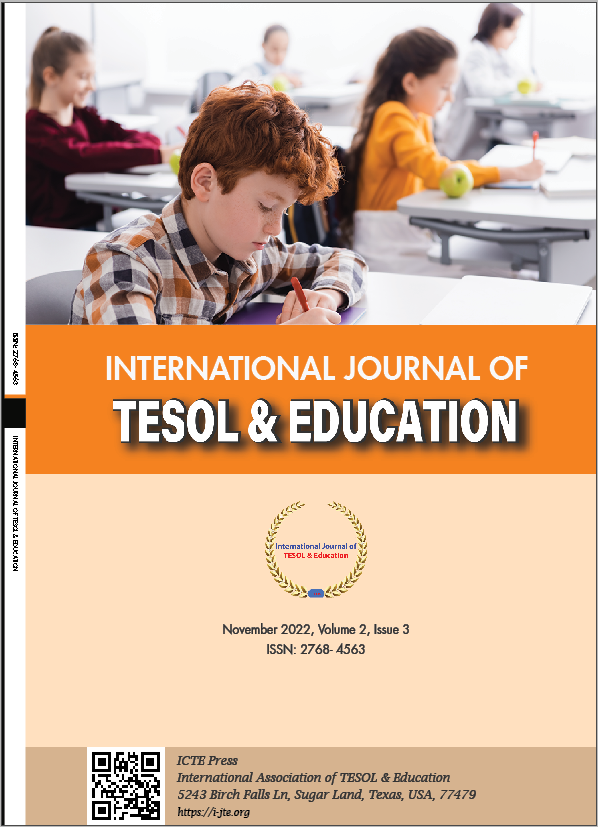Comparing Existential Sentences in Chinese, English and Vietnamese from the Perspective of Linguistic Typology
DOI:
https://doi.org/10.54855/ijte.222317Keywords:
Keywords: existential sentence, type of linguistics, syntax, order, asymmetricAbstract
Chinese existential sentences denote “somewhere appears, exists or disappears something or someone” (someone or something exists, appears or disappears somewhere). This paper comes from the perspective of semantics and syntax to analyze and find out more about the existential sentences of Vietnamese with English and Chinese, and compares the similarities and differences of the three components “component of place”; “verb indicating the existence”; the "existence subject" of the three languages. The paper has applied the cognitive theory of spatial relationships to explain the different orders of existential sentences in these three languages. The paper goes one step further with the preliminary study of existential sentences in Japanese, Korean, and Thai, and finds that Eastern languages can use the form of existential sentences to express two meanings: one is “in somewhere exists something”; and two is “in somewhere is lost something”, but Indo-European English cannot use the form of the existential sentence to express the idea “in somewhere is lost something”.
References
Chen, Q. (2010). Analysing the differences of existential sentences in English – English. Science & Technology Information, No. 22, 139. https://doi.org/10.3969/j.issn.1001-9960.2010.22.119
Diep, B. (1998). Vietnamese grammar. Education Press.
Fu, Y. (2009). Parsing and theoretical structure of existential sentences in English. China After School Education, No.8., 116. https://doi.org/10.3969/j.issn.1004-8502-B.2009.08.0098
Nguyen, N. M. (2021). Using Stories in Presenting English Grammar to Vietnamese Young Learners. International Journal of TESOL & Education, 1(3), 286–300. http://eoi.citefactor.org/10.11250/ijte.01.03.016
Gu, M & Li,L. (2010). The information structure of the existential sentences in English-Chinese from a cognitive perspective. Que Lam Education Academy Publishing House, No.10, volume 26. https://doi.org/CNKI:SUN:JJXK.0.2010-10-016
Hoang, P. (1980). Vietnamese grammar. (sentences). University Press.
Jia, Z. (2012). A study comparing existential Sino-English sentences, Master Thesis of Duong ChauUniversity. https://xueshu.baidu.com/usercenter/paper/show?paperid=1f11e7893c4eb116d9955ee8de0b9492&site=xueshu_se
Langacker, R.W.(1991). Fundations of Cognitive Grammer vol.II , Standford : Standford University Press.
Langacker, R.W. (2000). Grammar and Monceptualization , Berlin: Mouton de Gruyter.
Tran, Q. H. (2021). An Investigation into Non-English Major Students’ Problems in Taking Aptis Listening and Reading. International Journal of TESOL & Education, 1(3), 176–191. http://eoi.citefactor.org/10.11250/ijte.01.03.010
Xuan,W. (2008). Basic Korean Grammar, Social Science Publishing House, 1st. https://xueshu.baidu.com/usercenter/paper/show?paperid=6d9b8748601f08fd8c09eb7b69493bb2&site=xueshu_se
Downloads
Published
Issue
Section
License
Copyright (c) 2022 Vo Thi Quynh Trang

This work is licensed under a Creative Commons Attribution 4.0 International License.
The copyright of all articles published in the International Journal of TESOL & Education (ijte) remains with the Authors, i.e. Authors retain full ownership of their article. Permitted third-party reuse of the open access articles is defined by the applicable Creative Commons (CC) end-user license which is accepted by the Authors upon submission of their paper. All articles in the ijte are published under the CC BY-NC 4.0 license, meaning that end users can freely share an article (i.e. copy and redistribute the material in any medium or format) and adapt it (i.e. remix, transform and build upon the material) on the condition that proper attribution is given (i.e. appropriate credit, a link to the applicable license and an indication if any changes were made; all in such a way that does not suggest that the licensor endorses the user or the use) and the material is only used for non-commercial purposes.
Authors retain copyright and grant the journal the right of first publication with the work simultaneously licensed under a Creative Commons Attribution 4.0 International License that allows others to share the work with an acknowledgment of the work's authorship and initial publication in this journal.
Authors are able to enter into separate, additional contractual arrangements for the non-exclusive distribution of the journal's published version of the work (e.g., post it to an institutional repository, in a journal or publish it in a book), with an acknowledgment of its initial publication in this journal.











